How do you improve finnage? That question is asked way too many times !
Go and cross your HM to DTHM, that will improve the finnage.
Funny how we treat DT. If you look at DT on auction sites, it is rarely filled with posts. Not that many people sell DT. It's just not "hot" enough. But what you need to consider is....you need DT if you'd like to improve the finnage. So, you may not be able to sell it, but you need to keep it to improve your "other" lines, so that the "other" lines can be sold better. How ironic....at least that's how many other breeders have been treating DTs...
We personally love DT. Some of our best fish were DTs. However, it is difficult to get good DTs these days and our goal of experiments didn't involve much DTs, hence much lesser chance for us to play with the gene.
Tuesday 23 June 2009
Thin giant or short fat one?
Interesting observation on our current HM giant lines. There are 2 types of giants, so it seems, despite they are half siblings.
The first line has very thick body, but surprisingly shorter finnage. The bulkiness of the body is good sign, but why would the finnage shorter? Note that both parents are all extremely lengthy finnage...This makes these guys look like fat & short giant.
The second one is the opposite. Body-wise isn't particularly thick. Sure, the body is long, longer and bigger than your standard HM, but not to the extreme. We would love them to be about 1.5x to 2x in terms of body thickness....Finnage-wise, they are long and excessive, what we expect of a giant. This second line seems to be thin-body giant, more like a giant on a diet.
This same observation is also noticeable on HMPK giants, but because their finnage is already short, a lot of people didn't really pay much attention to it. Look at some of the giants available, you'll notice that there are some HMPKs with extremely large body but somewhat the finnage is way too short !
Things seem to be different if you have half-giant HMPK or 75% giants HMPK. Many of them look quite balanced (we're discounting those giants mixed with long fin betta, some of them come out with longer-than-usual finnage).
What do you have on your stock?
The first line has very thick body, but surprisingly shorter finnage. The bulkiness of the body is good sign, but why would the finnage shorter? Note that both parents are all extremely lengthy finnage...This makes these guys look like fat & short giant.
The second one is the opposite. Body-wise isn't particularly thick. Sure, the body is long, longer and bigger than your standard HM, but not to the extreme. We would love them to be about 1.5x to 2x in terms of body thickness....Finnage-wise, they are long and excessive, what we expect of a giant. This second line seems to be thin-body giant, more like a giant on a diet.
This same observation is also noticeable on HMPK giants, but because their finnage is already short, a lot of people didn't really pay much attention to it. Look at some of the giants available, you'll notice that there are some HMPKs with extremely large body but somewhat the finnage is way too short !
Things seem to be different if you have half-giant HMPK or 75% giants HMPK. Many of them look quite balanced (we're discounting those giants mixed with long fin betta, some of them come out with longer-than-usual finnage).
What do you have on your stock?
Friday 19 June 2009
Some pix from last few days
Having cleaned up, sort of, the tanks, we took the opportunity to take some shots.
This one is an interesting one. He is one of the smaller spawn with a few melano marbles. He is a giant geno, but by the look of it he's only carrying the gene of 25%. What's fascinating about these melanos is watching how they turn their colour from a complete black melano to some patchy one. This one is the extreme version where he only has some dots left :)

This one is coming from old line of copper mixed with lavendar. Not surprisingly the colour comes up as multi with lots of copperish. Nice ray branching though, starting to feather.
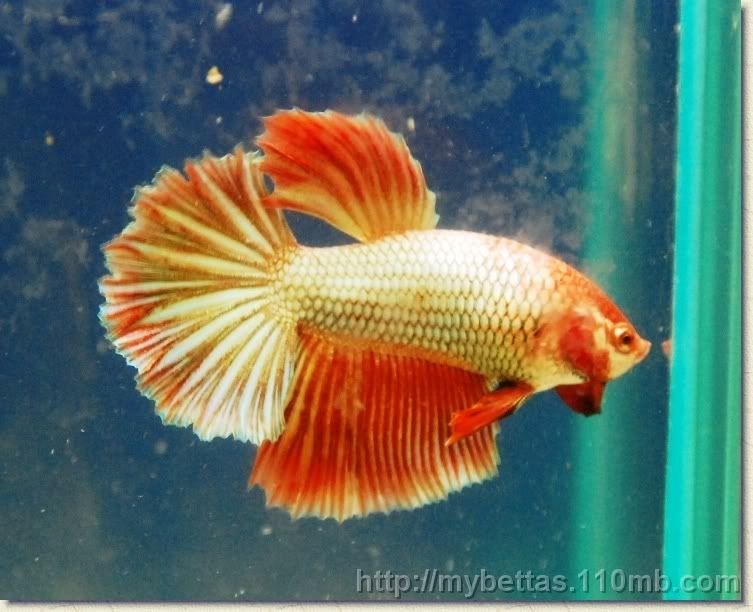
Again coming from copper line, this one is copper giant geno crosses. He's the only survival one from the spawn unfortunately as the parents, particularly the female, were extremely large, hence a difficult spawning. The beauty of this boy is on his colouration, a mixture of gold and red intertwined throughout the body and fins, pretty consistently. His spread isn't bad, body is pretty thick, but the boy is very naughty and managed to had a good fight with another male, hence all the torns in his fins.
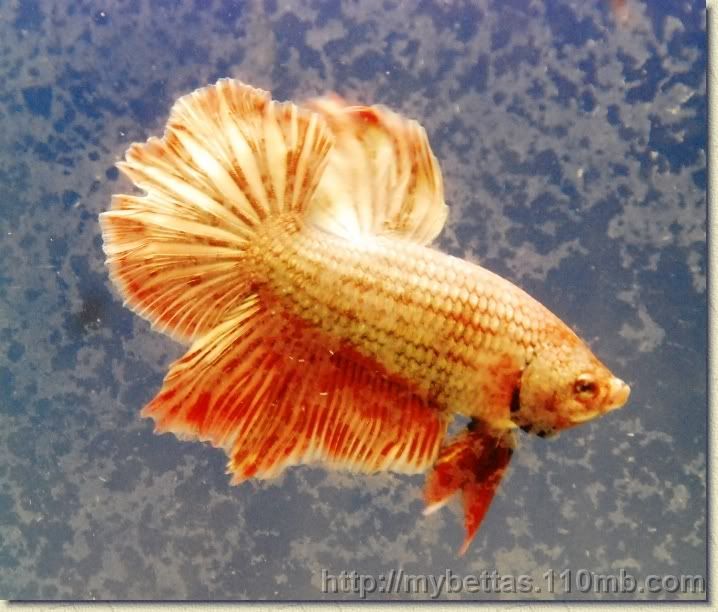
Finally, still admiring this boy, he's a very nice breeder-quality one...We've posted his pix when he was small till the size he's now, overall it's nice to see how they form and grow. Here are the pix again from small to big, just another flash back and waste of your bandwidth :)
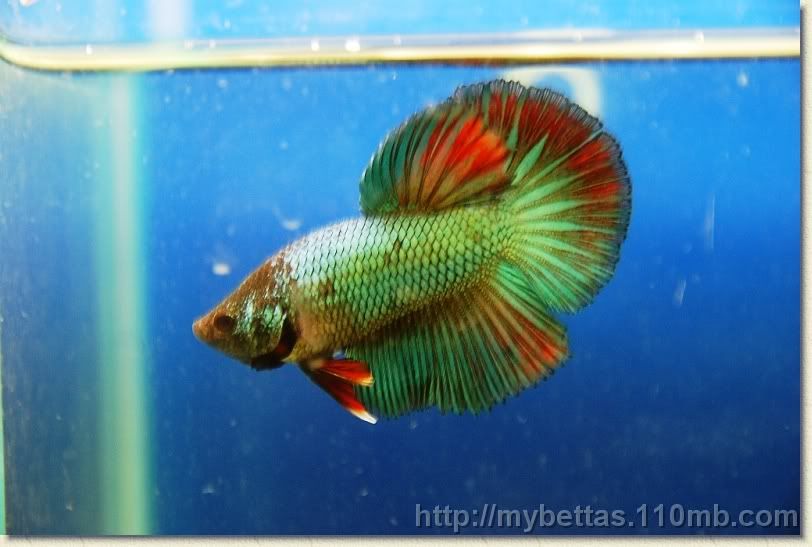

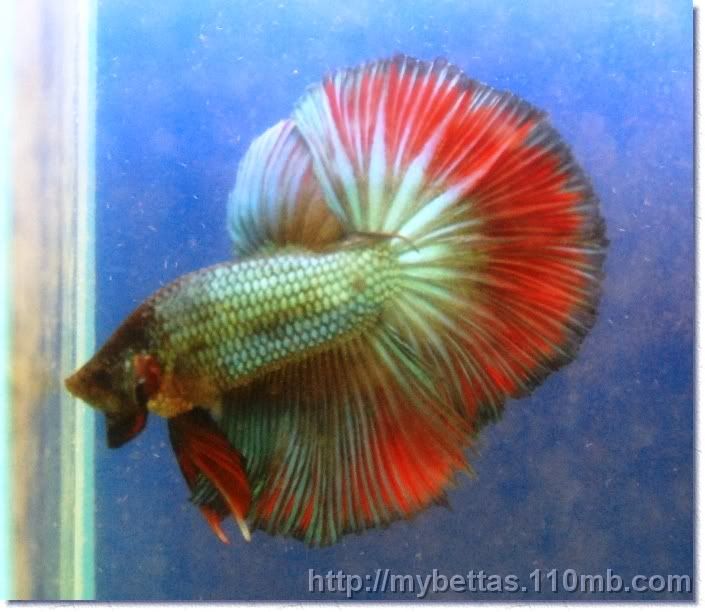
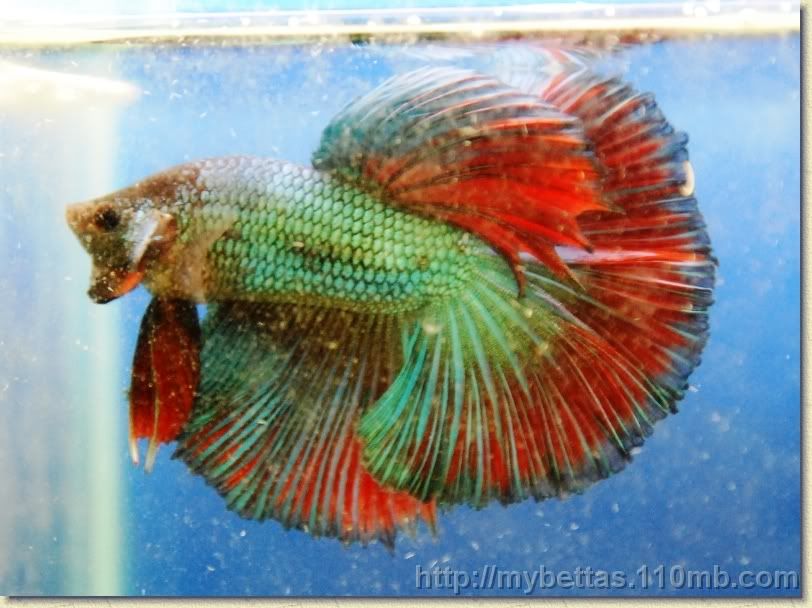
As mentioned, any of these guys you're interested in, shoot us email ;)
This one is an interesting one. He is one of the smaller spawn with a few melano marbles. He is a giant geno, but by the look of it he's only carrying the gene of 25%. What's fascinating about these melanos is watching how they turn their colour from a complete black melano to some patchy one. This one is the extreme version where he only has some dots left :)

This one is coming from old line of copper mixed with lavendar. Not surprisingly the colour comes up as multi with lots of copperish. Nice ray branching though, starting to feather.

Again coming from copper line, this one is copper giant geno crosses. He's the only survival one from the spawn unfortunately as the parents, particularly the female, were extremely large, hence a difficult spawning. The beauty of this boy is on his colouration, a mixture of gold and red intertwined throughout the body and fins, pretty consistently. His spread isn't bad, body is pretty thick, but the boy is very naughty and managed to had a good fight with another male, hence all the torns in his fins.

Finally, still admiring this boy, he's a very nice breeder-quality one...We've posted his pix when he was small till the size he's now, overall it's nice to see how they form and grow. Here are the pix again from small to big, just another flash back and waste of your bandwidth :)




As mentioned, any of these guys you're interested in, shoot us email ;)
Thursday 18 June 2009
Large tank vs small tank for breeding bettas
This seems to be a topic commonly asked by new beginners, should you choose largish tank or the smaller ones if you intend to breed bettas?
The answer really boils down to your preference and somewhat the personality of your bettas. Some bettas dont care really what kind of tank you provide them, so long the water condition is good for breeding. Some bettas are very fussy, they get "lost" in big tanks, grew tired of chasing the female and ended up on a prolonged dating. Such dating will only turn out as successful spawn when the female is ready to accept the "invitation" from the male.
What you also need to consider is that breeding is a lot easier if done in smaller tank. Anything as big as 10" or 12" tank (about 20cm in length) will do. The advantage of using smaller tank is that once the eggs hatched, you don't have to get headache on feeding them and they will find foods much easier, hence contributing to faster growth on their part. Note that once upon a time, when they are about 3 weeks or 1 month old, you can (and must) move them to larger tank.
So, the suggestion is...start it on smaller tank and move them to larger one as they grow.
BTW, if you're breeding extensively large giants, say those 4+" HM ones, then you need double the size of the tank mentioned above. The large giants dont like small tanks. The small tanks are mostly applicable for HMPK (giant or otherwise) and standard HM bettas.
Happy breeding :)
The answer really boils down to your preference and somewhat the personality of your bettas. Some bettas dont care really what kind of tank you provide them, so long the water condition is good for breeding. Some bettas are very fussy, they get "lost" in big tanks, grew tired of chasing the female and ended up on a prolonged dating. Such dating will only turn out as successful spawn when the female is ready to accept the "invitation" from the male.
What you also need to consider is that breeding is a lot easier if done in smaller tank. Anything as big as 10" or 12" tank (about 20cm in length) will do. The advantage of using smaller tank is that once the eggs hatched, you don't have to get headache on feeding them and they will find foods much easier, hence contributing to faster growth on their part. Note that once upon a time, when they are about 3 weeks or 1 month old, you can (and must) move them to larger tank.
So, the suggestion is...start it on smaller tank and move them to larger one as they grow.
BTW, if you're breeding extensively large giants, say those 4+" HM ones, then you need double the size of the tank mentioned above. The large giants dont like small tanks. The small tanks are mostly applicable for HMPK (giant or otherwise) and standard HM bettas.
Happy breeding :)
Friday 12 June 2009
When to cross out your bettas?
This question comes up a couple of times already. You may have a good line going on for awhile and wondering whether you should or should not cross out. Typical risks of cross out include introduction of unwanted traits into your line, but not crossing out isn't helping either.
So, how do you know that it's the time to cross out?
We usually cross our lines out as soon as F2 but on average on F4. There are occassions when we cross them out as soon as F1, but that's not the norm.
These are some indications when we cross our lines out:
Lots of mistakes are done when people afraid of doing inbreeding. There is tendency of crossing the fish out right away. While that is true and good if you'd like to start a new line, it is devastating if you don't know the history of your fish. Remember what's seen on the surface isn't necessary the genes you're ended up getting. But if you're only chasing the fun of breeding, by all means, take the best 2 of any fish and get them dancing :)
In short, develop your line to the point you know you "nearly" there, and only cross out when you have to or when you know crossing it out will get your much closer there. Crossing out frequently is fun, so from time to time do it...
So, how do you know that it's the time to cross out?
We usually cross our lines out as soon as F2 but on average on F4. There are occassions when we cross them out as soon as F1, but that's not the norm.
These are some indications when we cross our lines out:
- the new introduced fish is fitting to the plan and carry good quality
- your current line is starting to show some bad traits or defects
- your lines are no longer "strong", e.g. they are easily sick
Lots of mistakes are done when people afraid of doing inbreeding. There is tendency of crossing the fish out right away. While that is true and good if you'd like to start a new line, it is devastating if you don't know the history of your fish. Remember what's seen on the surface isn't necessary the genes you're ended up getting. But if you're only chasing the fun of breeding, by all means, take the best 2 of any fish and get them dancing :)
In short, develop your line to the point you know you "nearly" there, and only cross out when you have to or when you know crossing it out will get your much closer there. Crossing out frequently is fun, so from time to time do it...
Wednesday 3 June 2009
Interested on this boy?
Subscribe to:
Posts (Atom)




